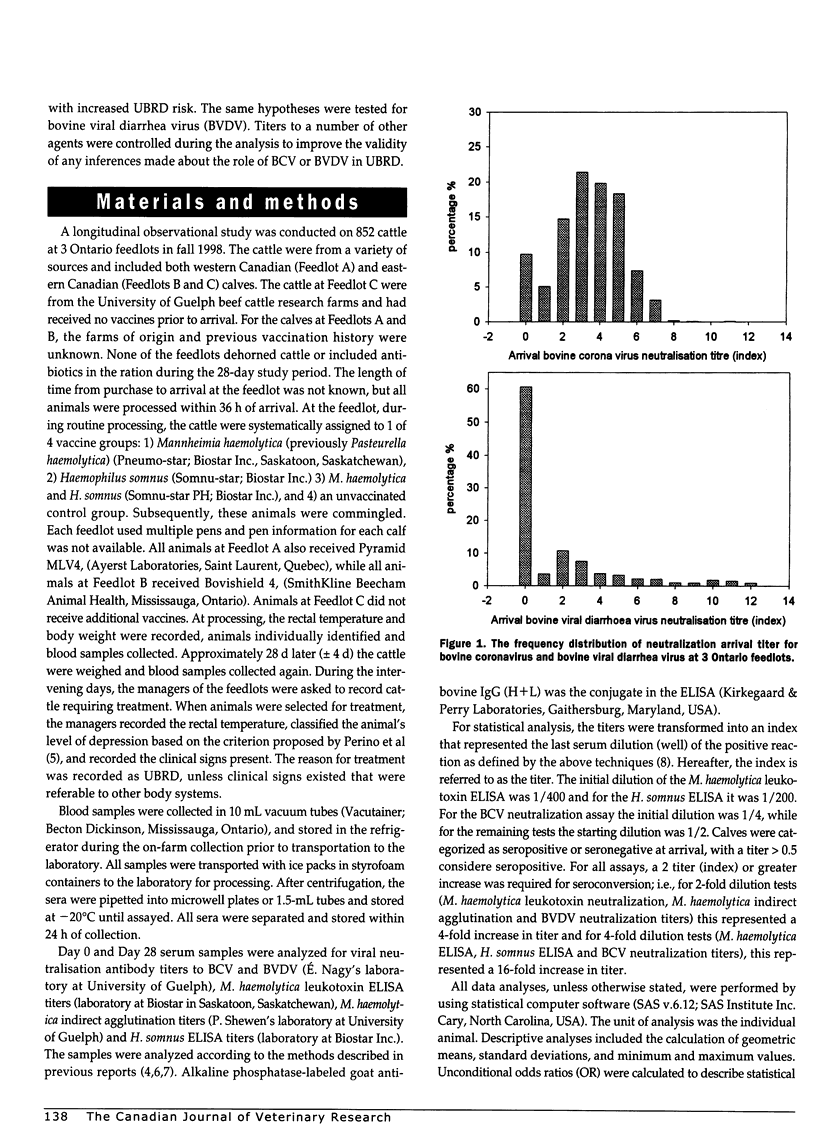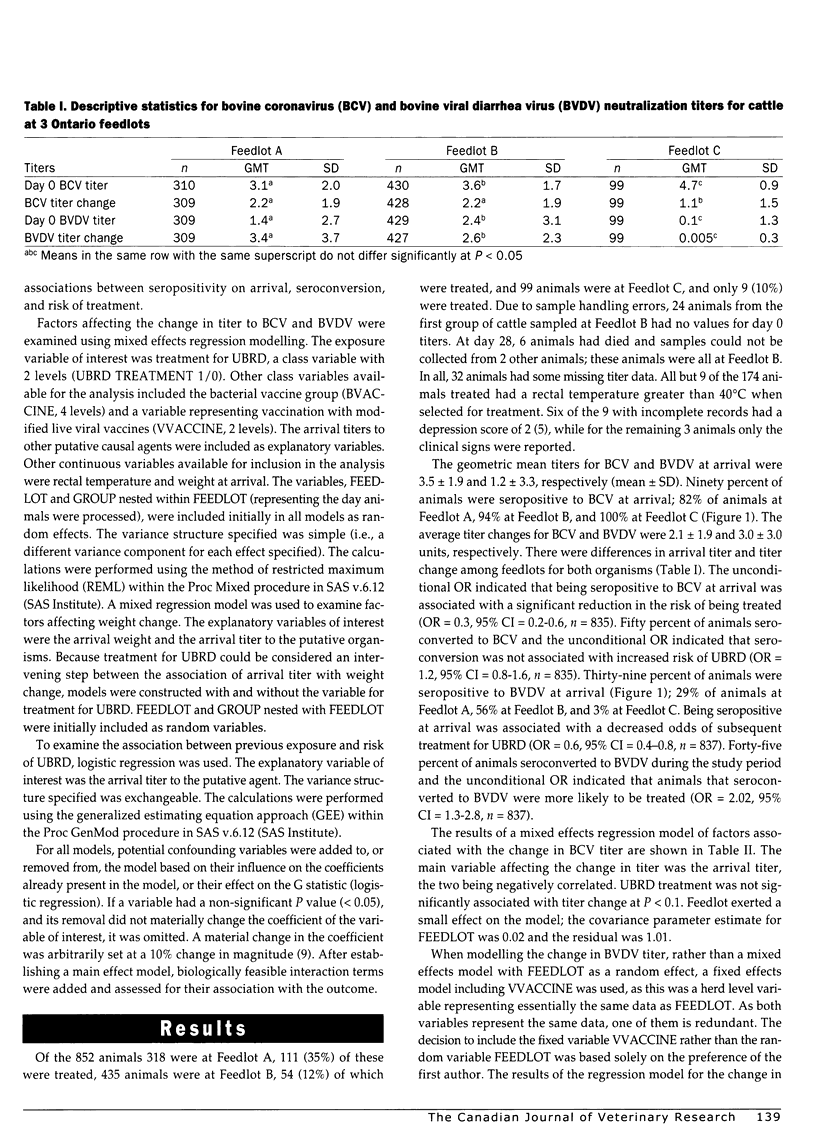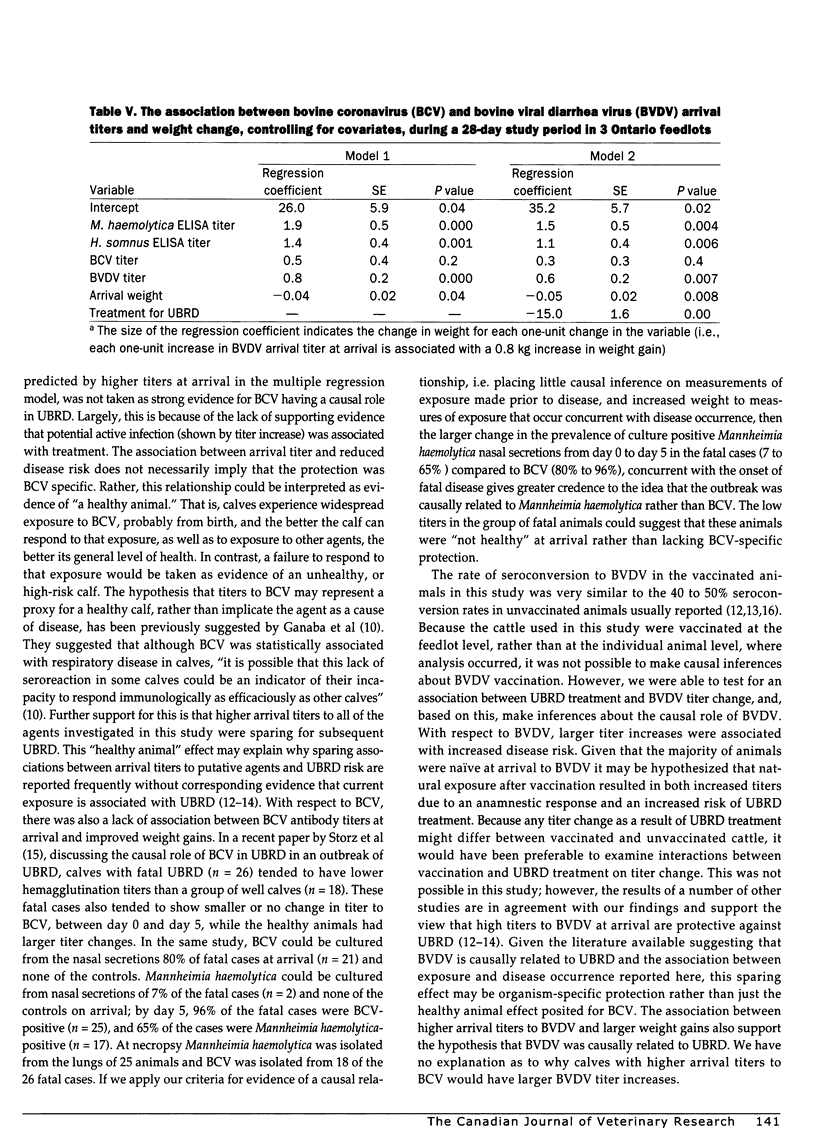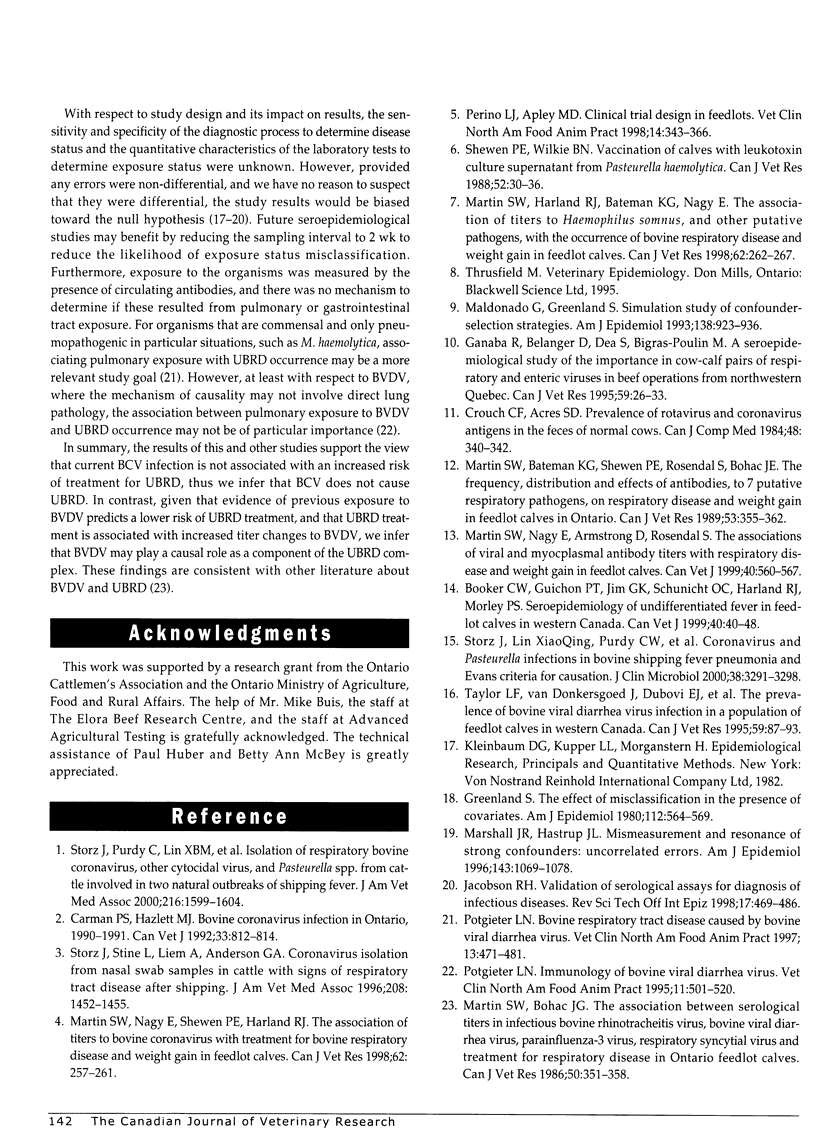Abstract
Serological evidence of previous viral exposure (titer at arrival) and current viral exposure (titer increase) during a 28-day study period, was used to determine if bovine coronavirus (BCV) or bovine viral diarrhea virus (BVDV) was associated with the occurrence of undifferentiated bovine respiratory disease (UBRD) in feedlot calves. Neutralizing antibody titers to BCV and BVDV were determined for 852 animals from 3 Ontario feedlots. Calves at 2 of the 3 feedlots (n = 753) received a modified live 4-way viral vaccine containing BVDV. On arrival at the feedlots, 90% of animals were seropositive for BCV, while 39% of animals were seropositive for BVDV. This evidence of previous exposure to both viruses was associated with reduced subsequent UBRD risk. Evidence of exposure to BCV during the study period was common, as 50% of animals showed a 16-fold or greater titer increase; however, treatment for UBRD was not associated with titer change. Although the majority of animals were vaccinated for BVDV at arrival, within a feedlot, animals treated for UBRD had larger titer increases to BVDV than non-treated animals. Based on our findings we infer that BCV was not causally related to UBRD occurrence, however consistent with other literature, BVDV may be causally related to UBRD occurrence.
Full text
PDF





Selected References
These references are in PubMed. This may not be the complete list of references from this article.
- Booker C. W., Guichon P. T., Jim G. K., Schunicht O. C., Harland R. J., Morley P. S. Seroepidemiology of undifferentiated fever in feedlot calves in western Canada. Can Vet J. 1999 Jan;40(1):40–48. [PMC free article] [PubMed] [Google Scholar]
- Carman P. S., Hazlett M. J. Bovine coronavirus infection in Ontario 1990-1991. Can Vet J. 1992 Dec;33(12):812–814. [PMC free article] [PubMed] [Google Scholar]
- Crouch C. F., Acres S. D. Prevalence of rotavirus and coronavirus antigens in the feces of normal cows. Can J Comp Med. 1984 Jul;48(3):340–342. [PMC free article] [PubMed] [Google Scholar]
- Ganaba R., Bélanger D., Dea S., Bigras-Poulin M. A seroepidemiological study of the importance in cow-calf pairs of respiratory and enteric viruses in beef operations from northwestern Quebec. Can J Vet Res. 1995 Jan;59(1):26–33. [PMC free article] [PubMed] [Google Scholar]
- Greenland S. The effect of misclassification in the presence of covariates. Am J Epidemiol. 1980 Oct;112(4):564–569. doi: 10.1093/oxfordjournals.aje.a113025. [DOI] [PubMed] [Google Scholar]
- Jacobson R. H. Validation of serological assays for diagnosis of infectious diseases. Rev Sci Tech. 1998 Aug;17(2):469–526. doi: 10.20506/rst.17.2.1119. [DOI] [PubMed] [Google Scholar]
- Maldonado G., Greenland S. Simulation study of confounder-selection strategies. Am J Epidemiol. 1993 Dec 1;138(11):923–936. doi: 10.1093/oxfordjournals.aje.a116813. [DOI] [PubMed] [Google Scholar]
- Marshall J. R., Hastrup J. L. Mismeasurement and the resonance of strong confounders: uncorrelated errors. Am J Epidemiol. 1996 May 15;143(10):1069–1078. doi: 10.1093/oxfordjournals.aje.a008671. [DOI] [PubMed] [Google Scholar]
- Martin S. W., Bateman K. G., Shewen P. E., Rosendal S., Bohac J. E. The frequency, distribution and effects of antibodies, to seven putative respiratory pathogens, on respiratory disease and weight gain in feedlot calves in Ontario. Can J Vet Res. 1989 Jul;53(3):355–362. [PMC free article] [PubMed] [Google Scholar]
- Martin S. W., Bohac J. G. The association between serological titers in infectious bovine rhinotracheitis virus, bovine virus diarrhea virus, parainfluenza-3 virus, respiratory syncytial virus and treatment for respiratory disease in Ontario feedlot calves. Can J Vet Res. 1986 Jul;50(3):351–358. [PMC free article] [PubMed] [Google Scholar]
- Martin S. W., Harland R. J., Bateman K. G., Nagy E. The association of titers to Haemophilus somnus, and other putative pathogens, with the occurrence of bovine respiratory disease and weight gain in feedlot calves. Can J Vet Res. 1998 Oct;62(4):262–267. [PMC free article] [PubMed] [Google Scholar]
- Martin S. W., Nagy E., Armstrong D., Rosendal S. The associations of viral and mycoplasmal antibody titers with respiratory disease and weight gain in feedlot calves. Can Vet J. 1999 Aug;40(8):560-7, 570. [PMC free article] [PubMed] [Google Scholar]
- Martin S. W., Nagy E., Shewen P. E., Harland R. J. The association of titers to bovine coronavirus with treatment for bovine respiratory disease and weight gain in feedlot calves. Can J Vet Res. 1998 Oct;62(4):257–261. [PMC free article] [PubMed] [Google Scholar]
- Perino L. J., Apley M. D. Clinical trial design in feedlots. Vet Clin North Am Food Anim Pract. 1998 Jul;14(2):343–365. doi: 10.1016/s0749-0720(15)30258-9. [DOI] [PubMed] [Google Scholar]
- Potgieter L. N. Bovine respiratory tract disease caused by bovine viral diarrhea virus. Vet Clin North Am Food Anim Pract. 1997 Nov;13(3):471–481. doi: 10.1016/s0749-0720(15)30309-1. [DOI] [PubMed] [Google Scholar]
- Potgieter L. N. Immunology of bovine viral diarrhea virus. Vet Clin North Am Food Anim Pract. 1995 Nov;11(3):501–520. doi: 10.1016/s0749-0720(15)30464-3. [DOI] [PubMed] [Google Scholar]
- Shewen P. E., Wilkie B. N. Vaccination of calves with leukotoxic culture supernatant from Pasteurella haemolytica. Can J Vet Res. 1988 Jan;52(1):30–36. [PMC free article] [PubMed] [Google Scholar]
- Storz J., Lin X., Purdy C. W., Chouljenko V. N., Kousoulas K. G., Enright F. M., Gilmore W. C., Briggs R. E., Loan R. W. Coronavirus and Pasteurella infections in bovine shipping fever pneumonia and Evans' criteria for causation. J Clin Microbiol. 2000 Sep;38(9):3291–3298. doi: 10.1128/jcm.38.9.3291-3298.2000. [DOI] [PMC free article] [PubMed] [Google Scholar]
- Storz J., Purdy C. W., Lin X., Burrell M., Truax R. E., Briggs R. E., Frank G. H., Loan R. W. Isolation of respiratory bovine coronavirus, other cytocidal viruses, and Pasteurella spp from cattle involved in two natural outbreaks of shipping fever. J Am Vet Med Assoc. 2000 May 15;216(10):1599–1604. doi: 10.2460/javma.2000.216.1599. [DOI] [PubMed] [Google Scholar]
- Storz J., Stine L., Liem A., Anderson G. A. Coronavirus isolation from nasal swab samples in cattle with signs of respiratory tract disease after shipping. J Am Vet Med Assoc. 1996 May 1;208(9):1452–1455. [PubMed] [Google Scholar]
- Taylor L. F., Van Donkersgoed J., Dubovi E. J., Harland R. J., van den Hurk J. V., Ribble C. S., Janzen E. D. The prevalence of bovine viral diarrhea virus infection in a population of feedlot calves in western Canada. Can J Vet Res. 1995 Apr;59(2):87–93. [PMC free article] [PubMed] [Google Scholar]


